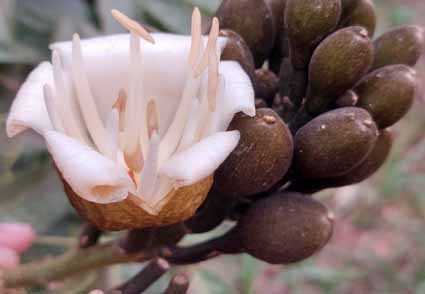Abstract
Alexa (Leguminosae, Papilionoideae) comprises nine species of Amazonian trees. An updated analysis of morphological variation in the genus indicated that material identified as Alexa grandiflora in herbaria constituted two distinct species, one of which appeared to be new. Subsequent fieldwork further supported the distinction. Here, we describe the new species, Alexa duckeana, which differs from A. grandiflora, most notably by lacking extrafloral glands and by having shorter pedicels and shorter racemes with more congested flowers. Alexa duckeana occurs only in the southeastern region of Pará, in northern Brazil. We assess its conservation status as Endangered. In addition to the description, we provide an illustration and distribution map for the new species, taxonomic comparisons, and an identification key for the species of Alexa that occur in Brazil.
References
- Allemão e Cysneiro, F.F. (1863) Sapotaceae. In: Martius, C.F.P. Flora Brasiliensis, vol. 7. pp. 39–45.
- Archer, W.A. (1962) Adolpho Ducke, Botanist of the Brazilian Amazon (1876-1959). Taxon 11 (8): 233–242. https://doi.org/10.2307/1217031
- Aublet, J.B.C.F. (1775) Decandria Monogynea. Classis X. In: Histoire des Plantes de la Guiane Françoise, vol. 1. pl. 143, f. 1. pp. 369–455.
- Aublet, J.B.C.F. (1775) Plantes de la Guiane Françoife. In: Histoire des Plantes de la Guiane Françoise, vol. 2 (Suppl.). pp. 1–40.
- Baillon, H.E. (1870) Du Xanthocercis, Genre Noveau De Dalbergiees. Sur Les Légumineuses-Papilionacées. Adansonia 9: 291–298.
- Benoist, R. (1921) Descriptions D’espéces nouvelles de Phanérogames. Bulletin du Muséum d’Histoire Naturelle 27: 111–116.
- Bonpland, A.J.A. (1807) Plantae Aequinoctiales, vol. 1. pl. 36, pp. 122–127.
- Brazil. (2012) Política de Recursos Hídricos do Estado do Pará. Secretaria de Estado de Meio Ambiente. Belém: Pará, pp. 117.
- Brown, R. (1826) Appendix pages. In: Denham, D. & Clapperton, H. (eds.) Narrative of Travels and Discoveries in Nothern and Central Africa. pp. 206–246.
- Cambessèdes, J. (1833) Lecythis. In: Saint-Hilaire, A., Jussieu, A. & Cambessèdes, J. (eds.) Flora Brasiliae Meridionalis, 4 ed., vol. 2 (20). pp. 1–381.
- Cardoso, D., Queiroz, L.P., Pennington, R.T., Lima, H.C., Fonty, E., Wojciechowski, M.F. & Lavin, M. (2012) Revisiting the Phylogeny of Papilionoid Legumes: New Insights from Comprehensively Sampled Early-Branching Lineages. American Journal of Botany 99 (12): 1–23. https://doi.org/10.3732/ajb.1200380
- Choi, I., Cardoso, D., Queiroz, L.P., Lima, H.C., Lee, C., Ruhlman, T.A., Jansen, R.K. & Wojciechowski, M.F. (2022) Highly Resolved Papilionoid Legume Phylogeny Based on Plastid Phylogenomics. Frontier Plant Science 13 (823190): 1–22. https://doi.org/10.3389/fpls.2022.823190
- Ducke, W.A. (1915) Plantes Nouvelles ou peu connues de la region amazonienne. Archivos do Jardim Botânico do Rio de Janeiro 1 (1): 5–58.
- Hooker, W.J. (1830) Botanical Miscellany, vol. 1. pl. 51, pp. 241–243.
- IUCN Standards and Petitions Committee. (2019) Guidelines for Using the IUCN Red List Categories and Criteria. Version 14. Prepared by the Standards and Petitions Committee. Available from: http://www.iucnredlist.org/documents/RedListGuidelines.pdf (accessed: 19 July 2023).
- Köppen, W. & Geiger, R. (1928) Klimate der Erde. Gotha: Verlag Justus Perthes.
- Linnaeus, C.V. (1753) Species Plantarum 2: 1190–1200.
- Legume Phylogeny Working Group. (2017) A new subfamily classification of the Leguminosae based on a taxonomically comprehensive phylogeny. Taxon 66: 44–77. https://doi.org/10.12705/661.3
- Miller, P. (1754) The Gardners Dictionary Abridged. ed. 4. London.
- Miranda, R.R. (2019) O agronegócio no Sudeste Paraense e as relações de trabalho. Revista Geoaraguaia 9 (2): 85–104.
- Miranda, R.R., Nogueira, L., Rodrigues, M., Alves, A., Costa, M. & Amador, M. (2021) Análise do desmatamento nos períodos de 2016 a 2020 na mesorregião sudeste paraense. Revista Ibero-Americana de Humanidades, Ciências e Educação 7 (5): 1–21. https://doi.org/10.51891/rease.v7i5.1209
- Monachino, J.V. (1952) The South American Species of Manilkara. Phytologia 4 (2): 93–118. https://doi.org/10.5962/bhl.part.18067
- Moquin-Tandon, A. (1849) Leguminosae. In: De-Candolle, A.P. (Ed.) Prodromus Systematis Naturalis Regni Vegetabilis. Vol. 13 (2). pp. 1–468.
- QGIS Development Team. (2020) QGIS Geographic Information System. Open Source Geospatial Foundation. Available from: https://qgis.org (accessed: 10 July 2023).
- Radford, A.E., Dickison, W.C., Massey, J.R. & Bell, C.R. (1974) Vascular Plant Systematics. Harper Collins, New York. pp. 891.
- Raiol, J.A. (2010) Perspectivas para o meio ambiente urbano: GEO Marabá. Programa das Nações Unidas para o Meio Ambiente (PNUMA). Programa das Nações Unidas para os Assentamentos Humanos (ONU-Habitat). Instituto Brasileiro de Administração (IBAM). Instituto de Estudos da Religião (ISER). Ministério do Meio Ambiente e Ministério das Cidades. Belém: Pará, pp. 140.
- Ramirez, N. (1995) Revisión taxonómica del género Alexa Moq. (Fabaceae, Sophoreae). Annals of the Missouri Botanical Garden 82: 549–569. https://doi.org/10.2307/2399836
- Schomburgk, R.H. (1845) Characters of two new plants discovered in British Guiana. London Journal of Botany 4: 12–13.
- Schreber, J.C.D. (1791) Genera plantarum. 8th ed., vol. 2. Francofurti ad Moenum [Frankfurt/Main]: sumtu Varrentrappii et Wenneri. pp. 380–872.
- Silva, T.M., Igawa, T.K., Oliveira Júnior, M.M., Watrin, O.S. & Venturieri, A. (2019) Trajetórias de uso e cobertura da terra nas Microrregiões de Marabá, Paragominas e Tucuruí, Sudeste Paraense (2004 - 2014). In: Simpósio Brasileiro De Sensoriamento Remoto. Anais. Instituto Nacional de Pesquisas Espaciais. Santos: São Paulo, pp. 2109–2112.
- Silva, G.S. (2023) Alexa in Flora e Funga do Brasil. Jardim Botânico do Rio de Janeiro. Available from: https://floradobrasil.jbrj.gov.br/FB78993 (Accessed 16 August 2023).
- Silva, G.S. (2020) Alexa in Flora do Brasil 2020. Jardim Botânico do Rio de Janeiro. Available from: https://floradobrasil2020.jbrj.gov.br/FB78993 (Accessed 16 August 2023).
- Thiers, B. (2023) [continuously updated] Index Herbariorum: A global directory of public herbaria and associated staff. New York Botanical Garden’s Virtual Herbarium. Available from: http://sweetgum.nybg.org/ih/ (accessed: 18 June 2023).
- Taubert, P.H.W. (1896) Leguminosae africanae I. In: Engler, A. (Ed.) Beiträge zur Flora von Africa. XII. Botanische Jahrbücher für Systematik, Pflanzengeschichte und Pflanzengeographie 23: 172–196.
- Yakovlev, G.P. (1977) Review the genre Alexa Moq. (Fabaceae, Angylocalyceae). Ukrajins’kyj Botaničnyj Žurnal 62 (3): 431–437.


